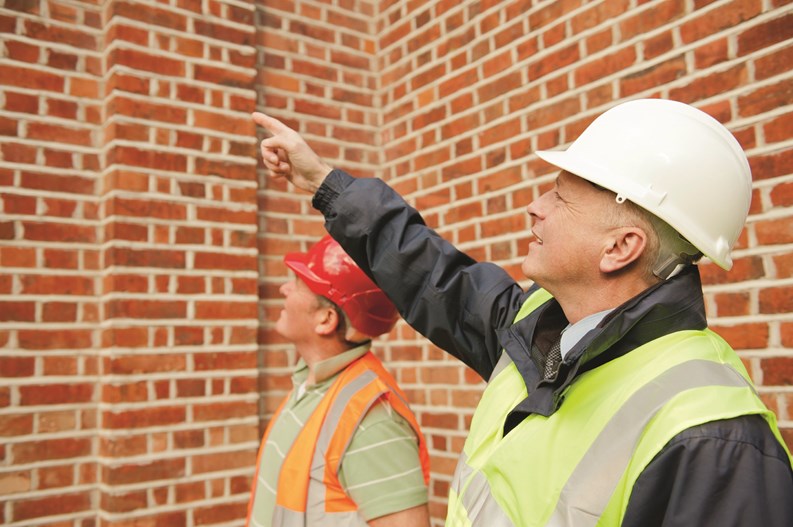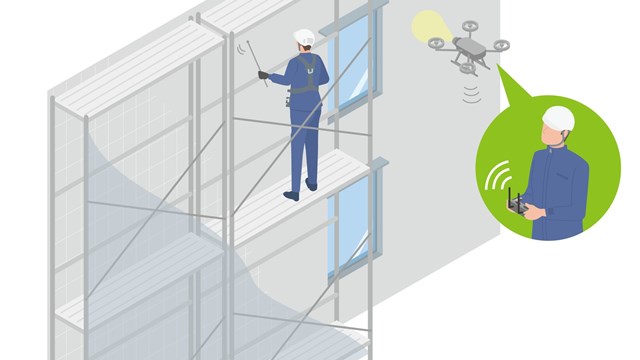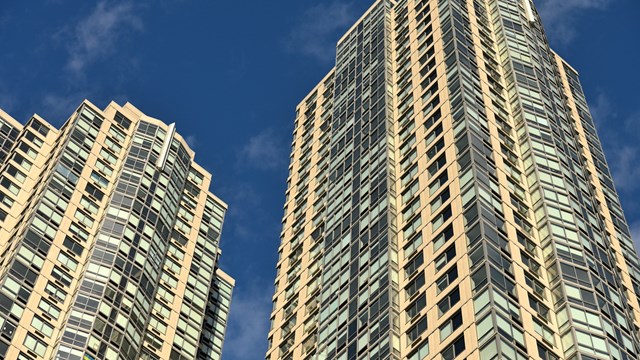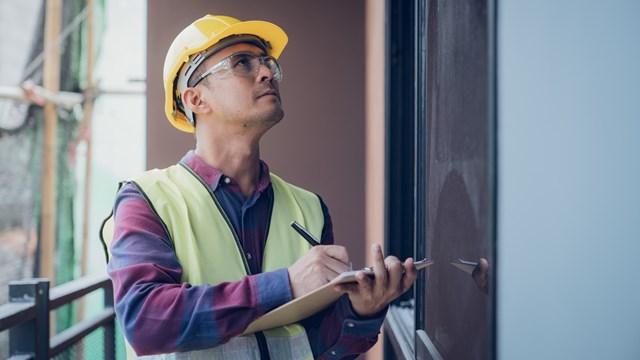Exteriors of buildings aren’t always smooth brick walls. There are all sorts of indentations and protrusions, from terraces to stonework, to cornices. There are also items that are not part of the building, but are affixed to it, like scaffolds and window air conditioners. And if such items are poorly secured or loose, this could lead to disaster.
Every once in a while, New Jerseyans will hear of a “high wind advisory,” usually in conjunction with a thunderstorm, hurricane, or nor’easter. And as strange as it may seem to people who equate tornadoes with places like Kansas and Oklahoma, a "downburst," which closely resembles such a windstorm event, hit Gloucester County this past June.
If something is loose on the exterior of your building, high winds make them vulnerable, whether you’re in the city itself or the suburbs. There are also other causes, such as construction accidents or material that comes loose after a number of years:
Consider these recent incidents in the tri-state area:
In West New York, New Jersey in June 2014, four people were injured when bricks fell from the second-floor façade of a building. The mayor, who is also a doctor, ran from his nearby office and helped the victims.
In May of this year, a two-year-old girl was left brain-dead and later died after bricks rained down on her and her grandmother. Terra cotta bricks fell from a window ledge of a seniors’ high-rise residential building on West End Avenue in Manhattan.
Also in May, a piece of mechanical equipment being lifted by a crane at a Manhattan office building broke free and fell 28 stories to the street below, injuring construction workers, pedestrians, and occupants of a passing car.
In September 2014, a not-too-stable window air conditioning unit plummeted from a sixth-floor window, hitting a pedestrian in the head and injuring her leg.
“I actually saw an A/C unit fall,” said Wayne Bellet, president of Bellet Construction in Manhattan. “It’s very frightening—it’s like a hand grenade. The pieces went everywhere.”
What kind of material or device, either affixed to the building, installed on the building or part of the building, could become loose and create potentially deadly hazards?
Among the many items are:
• Construction debris left on the roof or elsewhere (plywood, bricks, paint cans, ladders, tools, etc.)
• Loose bricks.
• Protective canopies used during construction.
• Scaffolds for workers who are doing work on the exterior of a building.
• Loose stonework.
• Terra cotta (mainly on older buildings).
• Siding material.
• Signage.
• Furniture on terraces and roof decks.
• Window air conditioning units and fans.
• Corrugated metal.
• Antennas and satellite dishes.
• Awnings.
• Planters and potted trees.
• Fences and guard rails.
• Solar panels.
• Coping stones, which form the top of a roof parapet wall.
• The urgency of some of the problems have changed over the years. “In the past,” says Bellet, “the worst offenders were antennas, both TV antennas and amateur radio (HAM) antennas. Then came the [satellite] dishes, which were worse, although we haven’t been seeing as many of them lately.”
It’s in the Code
Joseph Balzamo, president of Alliance Property Management in Morristown, notes that the Department of Community Affairs (DCA) helpfully lays out the statewide direction for building codes on its website. “We follow the code any time we are going to perform a repair on any structure,” he notes. “And depending on the size and scope of the work, we always ask the local building department to advise. That’s what they’re there for. It’s always better to investigate any restrictions or regulations up front, rather than to discover a problem further down the line.”
Contractors, engineers, and management companies who work in large geographical areas must also remember that building codes are different in every municipality. There are similarities between all of them, but it’s best for a board or management to hire a local attorney who knows the local building regulations.
The general nature of the building code is to protect the safety of a property’s occupants, as well as the safety of the people in the surrounding areas, according to Scott Piekarsky, the managing member of the law firm of Piekarsky & Associates, LLC in Wyckoff. “Everything is regulated by the state, and through various municipalities as well.”
Inspections In-Depth
Facades, balconies, fire escapes, guard rails and various other potentially hazardous equipment should be inspected regularly, not just at a building’s inception, to ensure the safety of residents. This is something that can be monitored by an association’s management. “If you have an outside property manager, depending on the agreement between their company and the association, they might be coming by weekly, or a few times per month,” says Piekarsky. “I represent some mid-rise properties with on-site staff, and, in those cases, they’re inspecting both the inside and outside of buildings with a lot more regularity.”
Joel Abreu, managing director of Total Management NYC, a management firm in Queens, New York, urges routine inspections to insure that building exteriors stay safe and nothing that is loose is dislodged.
“To make sure items are secured to the exterior of buildings and rooftops,” Abreu says, “the person inspecting must physically test how all items are affixed to the exterior and roof.” As we’ve mentioned, any items that seem loose should be removed immediately. The inspector should also notify management, staff, or a contractor to remove the item, or call for assistance.
If the victim of falling material and debris is not a passer-by but a construction worker, then the Occupational Safety and Health Administration (OSHA) comes into play. OSHA will do an investigation to find out whether that person is actually an employee, and whether it happened on the job.
If a construction employee thinks there is a hazardous condition on site, he or she must first notify his employer. If the employer doesn’t respond, then they can contact OHSA directly.
What You Can Do
What can contractors, building management, or building staff members do to secure exterior items and materials to make sure they stay put, even in high winds or other conditions? Also, what can they do to make sure they’re compliant with the code? In general, how can you make sure that your building won’t be the scene of a tragedy?
The professionals interviewed for this article had several valuable suggestions and insights.
“I have a weather alert that alerts everyone when high winds are coming. I’m a weather fanatic,” says Bellet. “You should be weather-aware.” Otherwise, he likes to keep a log to make sure that items are safe—for example, that deck furniture that isn’t bolted down is otherwise secure.
Roof deck furniture, he says, poses a particular challenge. “Some older people complain that the furniture is too heavy—they like to be able to move it around.” The trouble is, he says, that when the furniture is too light and there are high windstorms—for example, more than 60 miles an hour—“the tabletops, the wooden chairs fly on the roof or off the roof.”
And, says Scott Silberman, president of Manhattan-based SMS Engineering, P.C., deck furniture that’s too heavy can actually harm the roof by putting too much stress on it. In general, says Silberman, unit owners are often unaware of what can cause hazardous conditions. Many people put charcoal grills with propane tank-assisted starters on their terrace or the roof, he says, adding that “gas grills are illegal in New Jersey and New York. They should be electric.”
Abreu says that contractors, staff, and management should do routine walk-throughs of the roof to check if any items are not affixed properly, especially after storms. “Before heavy winds and storms, management, staff, and contractors (doing roof work on the building) should remove anything that can be blown away. Everything else that is affixed to the roof should be checked and reinforced,” he says.
Also, of course, managers and staff need to hire trained and licensed contractors, build any new structure up to code, and to make sure all work is code-compliant. In the end, much of what’s needed is simply common sense.
The Legal Angle, and Insurance
Let’s go back to the worst-case scenario. Any injury or fatality caused by falling debris, says Abreu, “will result in the injured party bringing about a lawsuit against the property, which results in the building having to protect itself by hiring an attorney, depending on the type of injury.
“In most cases, the building will also need to file a claim against the building’s insurance policy, and the insurance company will assign an attorney to represent and defend the property. We must also keep in mind that every time a claim is filed with the insurance company, the building’s insurance premium will increase.”
It’s like someone getting into a car accident, he explains. “The more claims you have, the less attractive the property becomes to the insurance providers, and the higher the premium will be.”
Raanan Geberer is a freelance writer and a frequent contributor to The New Jersey Cooperator. Staff writer Michael Odenthal contributed to this article.







Leave a Comment